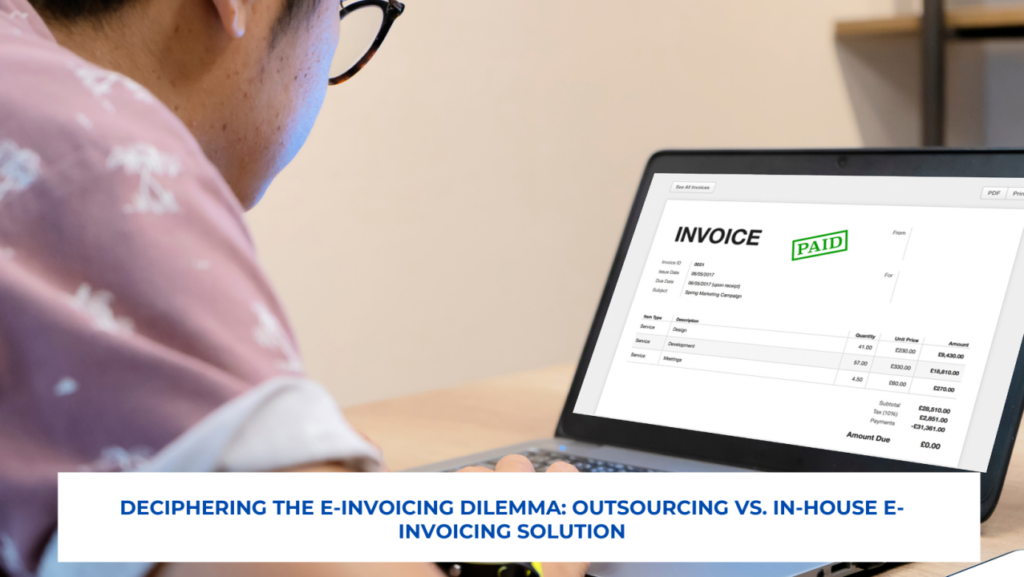
E-invoicing is becoming a more and more required practice as a result of the business world’s widespread digital transformation. Adopting e-invoicing has clear benefits, such as reduced costs and streamlined processes, but the actual implementation process can be challenging. Because of this complexity, businesses must decide whether to handle e-invoicing internally or by working with an outside provider.
Examining the benefits and drawbacks of implementing e-invoicing internally versus externally, this blog offers a framework to help companies select the best strategy for their particular requirements.
In-House e-invoicing solution
Unmatched customization and control: Companies maintain total control over the e-invoicing process, guaranteeing data security, easy integration with current accounting software, and flexibility to meet their unique set of needs. Product development goes considerably more quickly because a custom solution allows the company to adjust the details to suit their buyers better.
While developing an in-house e-invoicing solution gives flexibility and control, it also involves acquiring functional knowledge about tax compliance, technical and functional liaison with tax authorities, as well as comprehensive project management and product development expertise. The allocation of internal resources is crucial to ensuring the robustness and compliance of the e-invoicing solution. Therefore, investing in the necessary expertise and resources becomes important to develop a sound product that meets the standards set by ZATCA.
Partnering with an EGS, E-invoice Generating Solution
Cost-effective alternative: Outsourcing the e-invoicing solution to EGS providers in the market offers a cost-effective alternative to in-house implementation. By partnering with EGS providers, businesses can eliminate the need for large investments in technology and staff training, thus reducing upfront costs significantly. This approach is particularly beneficial for smaller companies with limited resources, as it allows them to access sophisticated e-invoicing solutions without bearing the financial burden of developing and maintaining an in-house system.
Leveraging local expertise: Outsourcing e-invoicing to EGS providers enables businesses to leverage local expertise and regulatory knowledge. These providers often have a deep understanding of local tax regulations and compliance requirements, ensuring that businesses remain aligned with the relevant standards. By entrusting the development and maintenance of the e-invoicing solution to EGS providers, businesses can mitigate compliance burdens and ensure adherence to regulatory frameworks such as ZATCA’s requirements.
Outsourcing e-invoicing to an EGS (E-invoice Generating Solution) offers relief from compliance burdens and ensures alignment with ZATCA’s requirements, yet it may introduce challenges. EGS platforms are typically tailored for broader market applicability, potentially limiting customization options. Consequently, businesses with intricate processes may encounter constraints. In such cases, considering an in-house approach for e-invoicing customization could be prudent.
When should you outsource?
The decision to outsource e-invoicing is not universally applicable. Numerous pivotal factors contribute to the complexity of the process and may suggest whether outsourcing is the optimal approach:
- Technical expertise: Technical expertise is crucial for effectively managing an e-invoicing system. If your company lacks the in-house capabilities to handle the complexities of e-invoicing technologies, outsourcing may be a more practical option. By partnering with a reputable vendor with specialized expertise, you can leverage their dedicated team of professionals to design, develop, and maintain the system while focusing on core business activities.
- Regulatory landscape: When contemplating e-invoicing strategies in KSA, understanding and complying with the stringent regulatory requirements, such as those outlined by ZATCA and VAT regulations, are paramount. These mandates dictate the format, content, and storage of electronic invoices, demanding meticulous adherence to avoid penalties and legal ramifications. Given the complexity of these regulations, businesses must evaluate their internal capabilities against the expertise required for compliance. In some instances, outsourcing to specialized providers may offer a more efficient and compliant solution, reducing the risk of non-compliance and regulatory breaches.
- Cost-benefit analysis: When weighing the decision between outsourcing e-invoicing or developing capabilities in-house, conducting a comprehensive cost-benefit analysis is crucial. This analysis involves evaluating the expenses associated with both options, including initial setup costs, ongoing maintenance expenses, and potential cost savings or efficiencies gained. By carefully assessing these financial considerations, businesses can determine the most cost-effective approach that aligns with their budgetary constraints and long-term strategic objectives.
Execution is the Key
In the context of e-invoicing for the Kingdom of Saudi Arabia (KSA), executing a successful implementation strategy is paramount. The Saudi Arabian Tax Authority (ZATCA) offers a simulation environment, which serves as a valuable testing ground for exploring different scenarios and invoice configurations before transitioning to production. This testing phase is crucial as it allows businesses to identify and rectify any issues or discrepancies in their e-invoicing processes, ensuring compliance with ZATCA’s requirements.
During the Phase 2 integration, it’s essential to adhere to ZATCA’s specifications meticulously. For example, ZATCA expects an XML file containing all the requisite data in the correct format. Any missing or incorrect data within the XML file can result in the rejection of invoices by ZATCA. In severe cases, non-compliance may even lead to penalties being imposed.
Furthermore, those responsible for executing the e-invoicing solution must navigate through a complex regulatory landscape. This includes adherence to e-invoicing regulations, Value-Added Tax (VAT) regulations, cybersecurity controls, and XML implementation standards.
To know more about Phase 1 and Phase 2 for KSA e-invoicing, check out our previous blog, Unveiling the Roadmap: Decoding Saudi Arabia’s E-Invoicing Journey towards Vision 2030.
Ultimately, the most effective approach to e-invoicing implementation depends on your specific business context, available resources, and risk tolerance. Take into account the factors outlined earlier, conduct comprehensive research, and evaluate pricing models offered by potential vendors before making a decision. By meticulously considering your options and choosing the approach that best aligns with your needs, your business can smoothly transition to e-invoicing, harnessing its numerous advantages to streamline financial workflows effectively.
Also, for seamlessly integrating your Xero accounting system with Marmin with just a click of a button, check out our blog, Xero Integration with Marmin: A Comprehensive Guide.
Reach out to us at hello@marmin.ai
